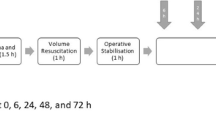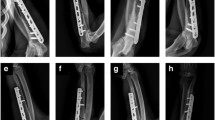Abstract
Objective
To determine the effect of high pressure pulsatile lavage (HPPL) and low pressure pulsatile lavage (LPPL) on cortical and soft tissue blood flow in a canine humerus segmental fracture model.
Design
Midshaft humeral osteotomies to create a 2-cm segment of diaphyseal bone were performed on bilateral canine humeri. Each osteotomy site was irrigated using either high pressure (n = 6) or low pressure (n = 5) pulsatile lavage prior to stabilization with a 5-mm steinman pin. Perfusion of cortical bone, periosteum, and biceps muscle was measured using Laser Doppler Flowmetry during four intraoperative intervals: pre-osteotomy, post-osteotomy, post-lavage, and post-nailing.
Results
Following osteotomy, a significant drop occurred in cortical perfusion (HPPL P = 0.049, LPPL P = 0.021) and in periosteal flow (HPPL P = 0.019, LPPL P = 0.012). Following irrigation there was no significant decrease in blood flow in either group for muscle (HPPL P = 0.249, LPPL P = 0.41), periosteum (HPPL P = 0.381, LPPL P = 0.402), or cortex (HPPL P = 0.398, LPPL P = 0.352) measurements. There was no significant difference between irrigation groups in post-lavage perfusion values for muscle (P = 0.326), periosteum (P = 0.452), and cortex (P = 0.464). Cortical perfusion decreased significantly post-nailing (HPPL P = 0.027, LPPL P = 0.047). Measurements did not differ significantly between groups at any other time interval.
Conclusion
Although previous work has demonstrated an association between HPPL and detrimental structural changes in bone, this study demonstrates that HPPL does not adversely affect cortical or soft tissue blood flow acutely. Further, LPPL offers no acute benefit to cortical or soft tissue perfusion.



Similar content being viewed by others
References
Bhandari M, Adili A, Lachowski RJ (1998) High pressure pulsatile lavage of contaminated human tibiae: an in vitro study. J Ortho Trauma 12:479–484
Bhandari M, Schemitsch EH, Adili A, Lachowski R, Shaughnessy SG (1999) High and low pressure pulstile lavage of contaminated tibial fractures: an in vitro study of bacterial adherence and bone damage. J Ortho Trauma 13:526–533
Bhaskar SN, Cutright D, Gross A (1969) Effect of water lavage on infected wounds in the rat. J Periodontol 40:671–672
Bhaskar SN, Cutright D, Hunsuck EE, Grass A (1971) Pulsating water jet devices in debridement of combat wounds. Mil Med 136:264–266
Brown LL, Shelton HT, Bornside GH, Cohn I (1978) Evaluation of wound irrigation by pulsatile jet and conventional methods. Ann Surg 187:170–173
Chapman M (1991) Open fractures. In: Rockwood CA, Green DP, Bucholz RW (eds) Fractures in adults, 3rd edn. JB Lippincott, Philadelphia, pp 223–264
Dirschl DR, Duff D, Miclair T, Dahners LE, Edin MI (1998) High pressure pulsatile irrigation of fresh fractures: effects on fracture healing. J Orthop Trauma 12:460–463
Esterhai JL, Queenan J (1991) Management of soft tissue wounds associated with type III open fractures. Orthop Clin North Am 22:427–432
Ger R (1970) Management of open fractures of the tibia with skin loss. J Trauma 10:112–117
Gross A, Bhaskar SN, Cutright DE (1971) The effect of pulsating water jet lavage on experimental contaminated wounds. J Oral Surg 29:187–190
Gross A, Cutright DE, Bhaskar SN (1972) Effectiveness of pulsating water jet lavage in the treatment of contaminated crushed wounds. Am J Surg 124:373–376
Gustilo RB (1982) Management of open fractures and their complications. WB Saunders, Philadelphia
Gustilo RB, Mendoza RM, Williams DN (1984) Problems in the management of Type III (severe open fractures: a new classification of Type III open fractures. J Trauma 24:742–746
Gustilo RB, Merkow RL, Templeman D (1990) The management of open fractures. J Bone Joint Surg Am 72:299–304
Gustilo RB, Nelson GE, Hamel A, Moe JH (1964) The effect of intramedullary nailing on the blood supply of the diaphysis of long bones in the adult dog. J Bone Joint Surg Am 46:1362–1363
Hamer ML, Robson MC, Krizek TJ, Southwick WO (1975) Quantitative bacterial analysis of comparative wound irrigations. Ann Surg 181:819–822
Hupel TM, Aksenov SA, Schemitsch EH (1998) Cortical bone blood flow in loose and tight fitting locked unreamed intramedullary nailing: a canine segmental tibia fracture model. J Orthop Trauma 12:127–135
Hupel TM, Aksenov SA, Schemitsch EH (1998) Effect of limited and standard reaming on cortical bone blood flow and early strength of union following segmental fracture. J Orthop Trauma 12:400–406
Klein MPM, Rhan BA, Frigg R, Kessler S, Perren S (1990) Reaming versus non-reaming in medullary nailing: inerference with cortical circulation of the canine tibia. Arch Orthop Trauma Surg 109:314–316
Madden J, Edlich RF, Schauerhamer R, et al. (1971) Application of principles of fluid dynamics to surgical wound irrigation. Curr Top Surg Res 3:85
McDonald WS, Nitcher LS (1994) Debridement of bacterial and particulate-contaminated wounds. Ann Plast Surg 33:142–147
Nilsson GE, Tenland T, Oberg PA (1980) A new instrument for continuous measurement of tissue blood flow by light beating spectroscopy. IEEE Trans Biomed Eng 27:12–19
Notzli HP, Swiontkowski MF, Thaxter ST, Carpenter GK III, Wyatt R (1989) Laser Doppler flowmetry for bone blood flow measurements: helium–neon laser light attenuation and depth of perfusion assessment. J Orthop Res 7:413–424
Patzakis MJ (1987) Management of open fracture wounds. In: Griffin P (ed) Institutional course lecture 36. CV Mosby Press, St Louis, pp 367–369
Rodeheaver GT, Pettry D, Thacker JG, Edgerton MT, Edlich RF (1975) Wound cleansing by high pressure irrigation. Surg Gynecol Obstet 141:357–362
Sanders RW, Swiontkowski MF, Nunley J, Speigel P (1993) The management of fractures with soft tissue disruptions. J Bone Joint Surg Am 75:779–789
Schemitsch EH, Benko R, Waddell JP (1996) Does a delay from time of injury to surgical intervention affect the incidence of infection after open fractures in multiple trauma? Presented at the 1996 Annual Meeting of the Orthopaedic Trauma Association, Boston, September 27–29
Schemitsch EH, Kowalski MJ, Swiontkowski MF, Harrington RM (1995) Comparison of the effect of reamed and unreamed intramedullary nailing on blood flow in the callus and strength of union following fracture of the sheep tibia. J Orthop Res 13:382–389
Sobel JW, Goldberg VM (1985) Pulsatile irrigation in orthopaedics. Orthopaedics 8:1019–1022
Strachan RK, McCarthy I, Fleming R, Hughes SP (1990) The role of the tibial nutrient artery. Microsphere estimation of blood flow in the osteotomized canine tibia. J Bone Joint Surg Br 73:1–394
Swiontkowski MF (1990) Surgical approaches in osteomyelitis. Use of laser Doppler flowmetry to determine nonviable bone. Infect Dis Clin North Am 4:501–512
Swiontkowski MF, Tepic S, Perren Sm, Moor R, Ganz R, Rahn BA (1986) Laser Doppler flowmetry for bone flow measurement: correlation with microsphere estimates and evaluation of the effect of intracapsular pressure on femoral head blood flow. J Orthop Res 4:362–371
West BR, Nichter LS, Halpern DE, Nimni ME, Cheung DT, Zhou ZY (1994) Ultrasound debridement of trabeculated bone: effective and atraumatic. Plast Reconst Surg 93:561–566
Wheeler CB, Rhodeheaver GT, Thacker JB, Edgerton MT, Edlich RF (1976) Side effects of high pressure irrigation. Surg Gynecol Obstet 143:775–778
Wilkins J, Patzakis M (1991) Choice and duration of antibiotics in open fractures. Orthop Clin North Am 22:433–437
Worlock P, Slack R, Harvey L, Mawhinney R (1988) The prevention of infection in open fractures. J Bone Joint Surg Am 70:1341–1347
Wray JB (1963) Vascular regeneration in the healing fracture: an experimental study. Angiology 14:134–138
Author information
Authors and Affiliations
Corresponding author
Rights and permissions
About this article
Cite this article
Di Pasquale, D.J., Bhandari, M., Tov, A. et al. The effect of high and low pressure pulsatile lavage on soft tissue and cortical blood flow: a canine segmental humerus fracture model. Arch Orthop Trauma Surg 127, 879–884 (2007). https://doi.org/10.1007/s00402-007-0417-5
Received:
Published:
Issue Date:
DOI: https://doi.org/10.1007/s00402-007-0417-5




